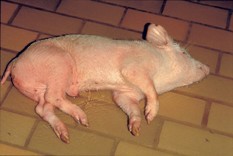What to look for
Classical swine fever affects only pigs. Infected pigs may appear:
- drowsy and depressed
- constipated (usually), but vomiting and diarrhoea can also occur
- to have gummy eyelids and red or purple blotching on the ears, snout, limbs and body
- to have respiratory distress and coughing.

Pigs appear drowsy and depressed
What you can do
- Do not move live animals, meat or meat products, untanned hides or skins, other animal products or soil out of the Torres Strait Protected Zone to the Torres Strait Permanent Biosecurity Monitoring Zone, or from either zone to mainland Australia without a permit and an inspection by a departmental biosecurity officer.
- Report any signs of illness in pigs to the Emergency Animal Disease Hotline on 1800 675 888.

Live animals, meat and dairy products, untanned hides and skins, other animal products and soil need a permit to move south between zones and to mainland Australia.
Profile
Classical swine fever is a highly contagious viral disease of pigs. There have been several outbreaks in Australia that have been eradicated in the past with no outbreaks since 1961. Australia is internationally recognised to be free of classical swine fever. While infected pigs spread the disease, the virus can also survive for a long time in frozen pig carcasses and cured or salted pork. It can stay alive in contaminated environments (for example pig pens) for up to two weeks and can be carried on clothing, shoes or vehicles. Sometimes pigs can be infected without showing signs, and if they are moved to another area they can spread the disease further.
Identification
Pigs with the acute disease appear drowsy and depressed. They huddle together, stagger when forced to move and can have convulsions and trembling. First they are constipated, but vomiting and diarrhoea are also common. They may have gummy eyelids and red or purple blotching on the ears, snout, limbs and body. Respiratory distress and coughing may also be present. Death usually follows.
Distribution
The disease is present in East and Central Africa, India, China, Asia, throughout Central and South America and outbreaks occur in Europe. In 1998 it spread east through Indonesia as far as Timor, and more recently, there is evidence of spread further east to West Papua. I Indications are that Papua New Guinea is free of the disease.
Threat
If classical swine fever got into Australia’s wild pig population it could spread to domestic pigs, resulting in disease and death for many animals and the loss of millions of dollars for the pork industry.
Keep a Top Watch!
If classical swine fever entered Australia, it could spread quickly and wipe out large sections of our pig industry. Keep a watch on wild pigs and if you see sick pigs or more deaths than usual, call the Emergency Animal Disease Hotline on 1800 675 888.
For further information or advice contact NAQS.
